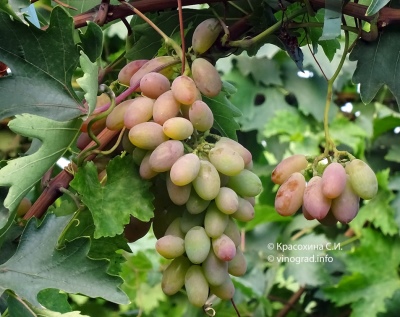
- Authors: OV "Grape Elita", Ukraine
- Appointment: dining room
- Berry color: white-pink
- Taste: harmonious
- Ripening period: early
- Ripening period, days: 115-125
- Frost resistance, ° C: -25
- Name synonyms: ZT-4-5
- Bunch weight, g: 450-800
- Flower type: bisexual
Table grapes have always been held in high esteem. Timur pink - improved progenitor selection. It is appreciated for its balanced composition of acids and sugars in berries. The bunches have an attractive appearance and high palatability.
Breeding history
Timur pink grapes appeared thanks to the work of Ukrainian breeders of the VO "Grape Elita". At the heart of a complex interspecific hybrid are genotypes of such varieties: Red Rapture and Timur.
Description
The bushes are compact. The vine grows well and is often used as a hedge. The leaves are medium in size, the surface is wrinkled, with carved edges.
Ripening period
It belongs to the early varieties. From flowering to full ripeness, 115-125 days pass. The first ripe fruits can be enjoyed in mid-August.
Bunches
Large, cylindro-conical in shape, on average one bunch can reach 450-800 g in weight. Their density is moderately loose.
Berries
The shape of the berries is oval-elongated with a sharp tip. As it ripens, the color changes from white-pink to pink-purple. The pulp is fleshy, firm and juicy. The skin is firm but edible. The fruits are large. The weight of one reaches 9-10 g.
Two-three-year-old seedlings have drawbacks in the form of uneven color of fruits and their cracking after rains. With the maturation of the bush, these shortcomings pass.
Taste
It has a pleasant, harmonious taste. At the initial stage of technical ripeness, astringency prevails in the taste, gradually it completely disappears, becoming sweet. The calorie content is very high. According to a ten-point tasting assessment, the variety is rated at 8.2 points.
Yield
High-yielding. With proper care, up to 10 kg of grapes can be harvested from one bush.


Growing features
Demanding in care, even more than other species. Very sensitive to the lack of attention. Manifesting this with a meager harvest or even the death of the plant.
In order to develop normally and actively bear fruit every year, the following rules should be observed.
The plant is hygrophilous. Therefore, watering should be plentiful, especially during periods of flowering and fruit formation. In dry weather, irrigation is increased several times. If this is neglected, the yield will be minimal, and the berries themselves will become small.
For less moisture loss from the soil around the bush, it is imperative to mulch with straw, sawdust, moss.
Additional organic and mineral nutrition plays an important role in the good development of grapes. Top dressing is applied twice a year.
Landing
It is not difficult to grow a hybrid on the site. He has good survival rates. Grapes are propagated in several ways:
grafting of seedlings;
grafting the cutting to the roots of other varieties;
rooting with layering;
sowing and germination of grape seeds.
Experienced growers use the method of grafting other varieties to the roots. This method allows you to save Timur pink from such significant drawbacks as exactingness to the composition of the soil and the miniature size of the bushes. While increasing the number of fruit vines and increasing the yield.
Using green cuttings as planting material, they need to be grafted in early spring, until the juice has moved. This allows you to protect them from cold and frost. Saplings with roots are best planted in the fall. There is still enough moisture and essential nutrients in the soil.
Before landing, you need to decide on a place. Better to plant in a sunny area, protected from wind and drafts. Ideal would be the south side along the wall of the house or fence. The interval should be 3-4 meters from the building, as the plant is vigorous.
The hybrid is quite picky about the composition of the soil. It should be fertile, the pH should vary in the range of 5.5-7, moisture-permeable, without stagnant water. When the soil is not suitable, it must be prepared by applying organic and mineral fertilizers.

Pollination
The plant is bisexual. There is no need to plant pollinator grapes nearby. Fruit ovary occurs almost 100%, without peas.
Pruning
Vines are pruned 2 times a year. In autumn, up to 6-8 eyes are left on each shoot, the fruiting vine is removed. In the spring, about 30-40 fruit buds are formed on one bush, it is advisable to leave no more than 20. This allows you to achieve the largest possible bunches and not burden the vine.



Frost resistance and the need for shelter
The plant is able to withstand frosts down to -25 degrees. But despite the good indicators of frost resistance, it is necessary to cover it every year for the winter. In the southern regions, where there are no harsh winters, this need disappears.

Diseases and pests
It resists many diseases well. Resistance to mildew and gray rot 2.5 points, and 3.5 points to powdery mildew. But do not neglect preventive measures and carry out treatment with special drugs annually.

If a grape is exposed to any disease or insect, this always affects its appearance.
Storage
Shows good indicators of transportability, however, it may not lie for a long time, quickly losing its presentation (crumble from the stalk).











































































